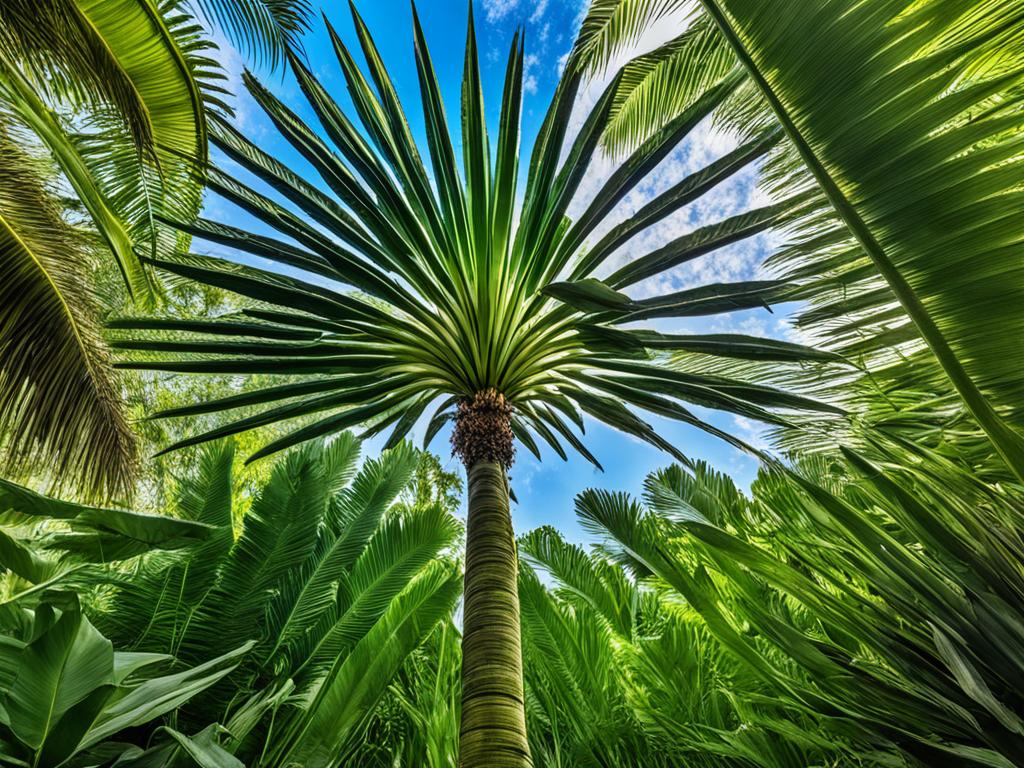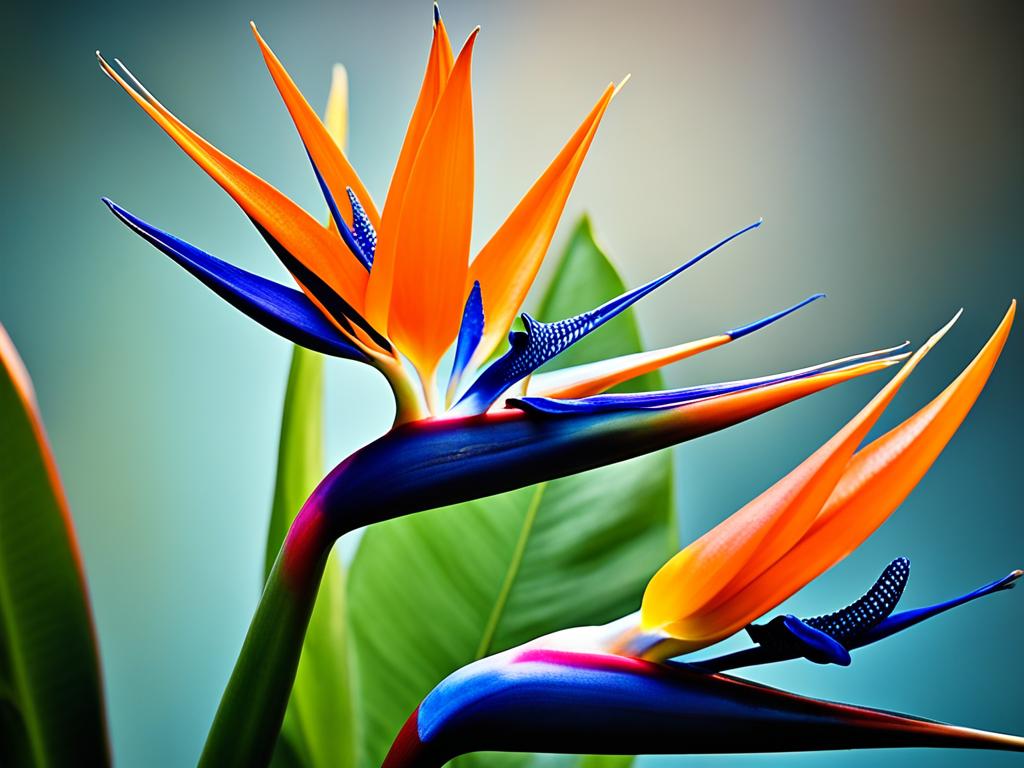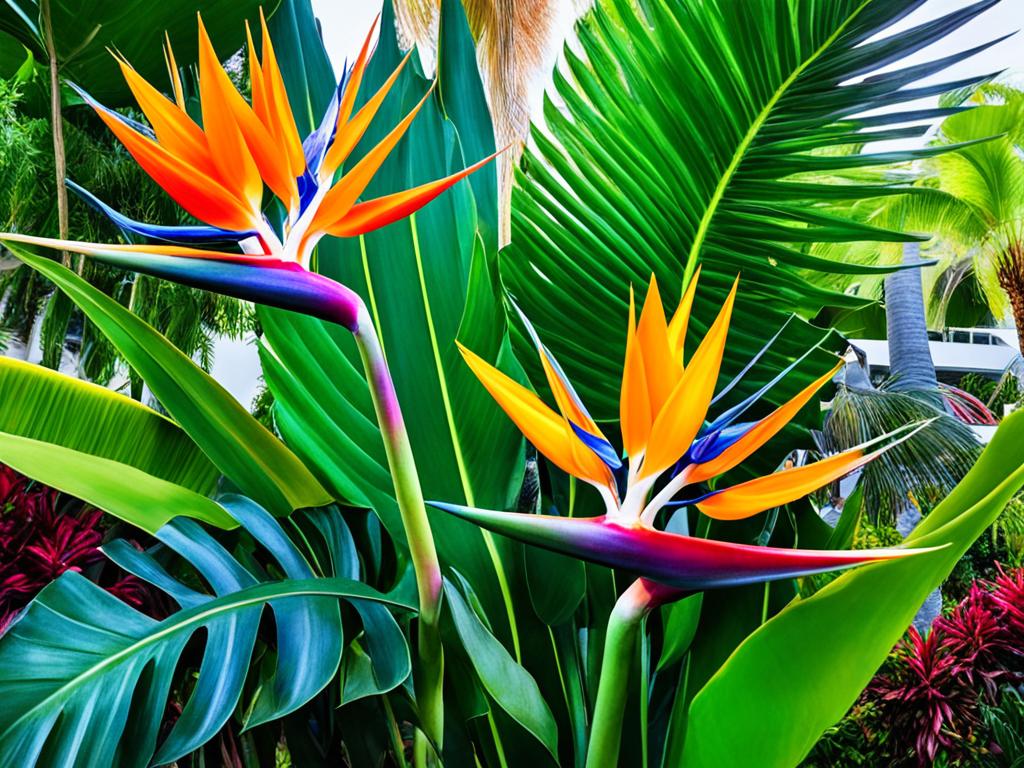Are you searching for the best landscaping foliage to enhance your outdoor space? Look no further than tropical plants like the Bird of Paradise and Travelers Palm. These exotic garden species are popular choices for their striking appearance and ability to thrive in sunny climates.
When it comes to popular ornamental plants, the Bird of Paradise and Travelers Palm top the list. Their unique plant characteristics and vibrant foliage make them excellent choices for garden design. But how do these two plants compare? Let’s dive into a detailed comparison to help you make an informed decision for your landscape.
Key Takeaways:
- The Bird of Paradise and Travelers Palm are both exotic tropical plants for outdoor landscaping.
- These plants thrive in sunny climates and add a touch of beauty to any garden.
- The Bird of Paradise is known for its colorful bird-shaped blooms, while the Travelers Palm has striking fan-shaped leaves.
- Travelers Palms can reach impressive heights, while Bird of Paradise plants are smaller in size.
- Consider your climate, size requirements, and intended use (indoor or outdoor) when choosing between these plants.
An Overview of Traveler Palm
The Traveler Palm, scientifically known as Ravenala madagascariensis, is a stunning tropical plant native to Madagascar. It is not a true palm but belongs to the banana family (Strelitziaceae). It is known for its graceful, fan-shaped leaves that can reach up to 7-10 feet in length and resemble the shape of a traditional hand fan. The plant can grow up to 20-30 feet in height with a single trunk and has deep green foliage with a glossy finish.
The Traveler Palm is more tolerant of cooler temperatures compared to the Bird of Paradise, making it a great choice for gardeners in slightly colder regions. Additionally, its foliage remains vibrant and green throughout the year, adding a touch of tropical beauty to any landscape.
This tropical plant can be propagated through division or by growing from seeds. It is recommended to divide the plant during early spring when new growth emerges. Alternatively, you can collect fresh seeds and plant them in well-draining soil, keeping them consistently moist until germination occurs.

The Traveler Palm is an ideal choice for creating a lush, tropical atmosphere in your garden. It pairs well with other tropical plants and can be used as a focal point or planted in a row to create an eye-catching boundary. Whether you have a small backyard or a large estate, the Traveler Palm’s impressive height and distinctive foliage make it a standout addition to any landscape design.
An Overview of Bird of Paradise
The Bird of Paradise plant, known scientifically as Strelitzia reginae, is another captivating tropical plant. It is native to South Africa and belongs to the Strelitziaceae family. The plant stands out with its large, paddle-shaped leaves that grow on long stalks. It also features striking, bird-shaped blooms in various shades of orange and blue. Bird of Paradise plants typically grow up to 4-6 feet tall and have a clumping growth habit with multiple stems. They thrive in tropical and subtropical climates and can be propagated through division or by collecting and planting seeds.

Physical Characteristics of Bird of Paradise
- Banana-like leaves
- Bird-shaped blooms
- Height: 4-6 feet
- Clumping growth habit
Temperature Tolerance and Growing Conditions
Bird of Paradise plants are well-suited for tropical and subtropical climates. They thrive in warm and humid environments with temperatures ranging from 65°F to 85°F (18°C to 29°C). These plants have a moderate tolerance for cooler temperatures, but they may suffer damage if exposed to frost or freezing temperatures.
Propagation Methods
Bird of Paradise plants can be propagated through two main methods: division and seed planting.
Division: To propagate through division, gently separate the clumps or offsets from the main plant and replant them in separate pots or garden beds. Each division should have a healthy root system and a portion of the stem.
Seed Planting: Bird of Paradise plants produce capsule-like seed pods after flowering. Collect the mature pods, remove the seeds, and soak them in warm water for a day or two. Plant the seeds in well-draining soil, keep them consistently moist, and provide warm temperatures for germination.
Benefits of Bird of Paradise in Landscaping
Bird of Paradise plants are popular choices for landscaping due to their stunning appearance and unique features. Here are a few reasons why you might consider incorporating Bird of Paradise into your garden design:
- Exotic and tropical aesthetics.
- Attracts birds and butterflies.
- Low maintenance once established.
- Can be grown in pots or containers.
- Provides vertical interest and structure.
- Excellent for creating focal points or borders.
| Property | Bird of Paradise |
|---|---|
| Common Name(s) | Bird of Paradise |
| Scientific Name | Strelitzia reginae |
| Family | Strelitziaceae |
| Native to | South Africa |
| Leaf Shape | Banana-like |
| Flower Shape | Bird-shaped |
| Height | 4-6 feet |
| Growth Habit | Clumping |
| Temperature Tolerance | Tropical and subtropical |
| Propagation Methods | Division, seed planting |
Key Differences Between Traveler Palm and Bird of Paradise
When comparing the Traveler Palm and Bird of Paradise, several key differences become apparent. Understanding these distinctions can help you make an informed decision when selecting the ideal plant for your landscaping needs.
Size Comparison
The Traveler Palm is an impressive plant that can reach towering heights of up to 20-30 feet, making it a majestic presence in any outdoor space. In contrast, Bird of Paradise plants tend to be smaller, typically growing to a height of 4-6 feet. This disparity in size can greatly impact the overall aesthetic and visual impact of your landscaping design.
Growth Habit
An important distinguishing feature between the Traveler Palm and Bird of Paradise is their growth habit. Traveler Palms have a clumping growth habit, with multiple stems emerging from the ground, giving them a fuller and more abundant appearance. On the other hand, Bird of Paradise plants have a solitary trunk, creating a more streamlined and compact growth pattern.
Temperature Tolerance
Another significant difference lies in their temperature tolerance. The Traveler Palm is known for its ability to withstand cooler temperatures compared to the Bird of Paradise. This makes it a suitable choice for outdoor landscaping in regions with cooler climates or occasional frost. Bird of Paradise plants, on the other hand, thrive in tropical and subtropical climates, making them better suited for indoor cultivation or warmer outdoor environments.
Container Suitability
Considering container gardening? While both plants can be cultivated in pots and containers, the Bird of Paradise is a particularly popular choice for indoor cultivation. Its smaller size, manageable growth habit, and adaptability to container living make it an ideal plant for adding a touch of tropical beauty to your indoor space.
Landscaping Uses
When it comes to landscaping applications, the Traveler Palm’s substantial height and impressive size make it a preferred choice for creating dramatic focal points or adding height to your outdoor design. Its fan-shaped leaves also contribute to its tropical allure. Conversely, Bird of Paradise plants are versatile and can be used in various landscaping designs. Their vibrant, bird-shaped blooms and clumping growth habit make them excellent choices for borders, mixed beds, or as standalone feature plants.

As you can see, the Traveler Palm and Bird of Paradise offer distinct characteristics that can enhance any landscape. By considering factors such as size comparison, growth habit, temperature tolerance, container suitability, and landscaping uses, you can make an informed decision when choosing between these two tropical plants.
Conclusion
In conclusion, the Bird of Paradise and Traveler Palm are both stunning tropical plants that offer unique characteristics and can elevate the beauty of any landscape. The Traveler Palm impresses with its tall height and elegant fan-shaped leaves, while the Bird of Paradise captures attention with its vibrant blooms and clumping growth habit. These plants present you with exciting landscaping choices, allowing you to create a tropical oasis in your garden design.
When deciding between the Bird of Paradise and the Traveler Palm, several factors should be considered. Take into account your specific climate and the size requirements of your outdoor space. If you prefer a larger and more dramatic feature, the Traveler Palm’s towering stature may be the perfect fit. On the other hand, if you are looking for a versatile option that can thrive indoors or in smaller areas, the Bird of Paradise’s compact size and container suitability make it an excellent choice.
Importantly, the unique plant characteristics of the Bird of Paradise and Traveler Palm make them stand out. The Bird of Paradise’s eye-catching bird-shaped blooms and the Traveler Palm’s glossy, hand fan-shaped leaves will undoubtedly enhance the visual appeal of your landscape. With their distinctive traits and natural allure, these tropical plants effortlessly lend an exotic touch to any garden design, creating a serene and tropical ambiance.
Whether you opt for the Bird of Paradise or the Traveler Palm, you can count on their exceptional qualities to transform your outdoor space into a tropical paradise. So, explore the differences, consider your preferences, and embark on a landscaping journey that delights the senses and offers a unique and captivating environment for years to come.
FAQ
What are the main differences between Bird of Paradise and Traveler Palm?
Bird of Paradise plants are smaller, growing up to 4-6 feet tall, while Traveler Palms can reach heights of 20-30 feet. Bird of Paradise plants have a clumping growth habit with multiple stems, while Traveler Palms have a solitary trunk. Traveler Palms are more tolerant of cooler temperatures compared to Bird of Paradise plants.
Can Bird of Paradise and Traveler Palm be grown in containers?
Yes, Bird of Paradise plants can thrive in pots and containers, making them a popular choice for indoor cultivation. Traveler Palms, on the other hand, are better suited for outdoor landscaping due to their height and size.
How do you propagate Bird of Paradise and Traveler Palms?
Both Bird of Paradise and Traveler Palms can be propagated through division, where the plant is divided into smaller sections and replanted. They can also be grown from seeds by collecting mature seeds and planting them in a suitable growing medium.
Do Bird of Paradise and Traveler Palm have any unique characteristics?
Yes, Bird of Paradise plants are known for their large, paddle-shaped leaves and striking, bird-shaped blooms in shades of orange and blue. Traveler Palms, on the other hand, have graceful, fan-shaped leaves that resemble a hand fan.
What are the ideal climates for growing Bird of Paradise and Traveler Palm?
Bird of Paradise plants thrive in tropical and subtropical climates, while Traveler Palms are native to Madagascar and are well-suited for similar warm climates.



